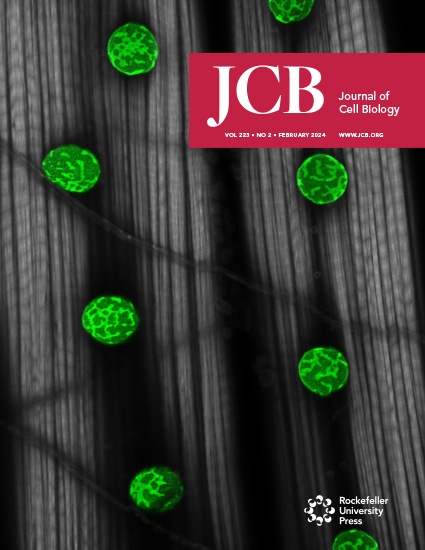中心粒卫星在中心体和纤毛蛋白翻译中的保守作用。
IF 7.4
1区 生物学
Q1 CELL BIOLOGY
引用次数: 0
摘要
向心卫星是在中心体和纤毛附近发现的细胞质颗粒,其具体的功能贡献长期以来一直不清楚。在这里,我们确定Combover是卫星的主要脚手架组件PCM1的果蝇同源物。与PCM1一样,Combover定位于含有中心体蛋白的细胞质病灶,其缺失或突变导致中心体和纤毛表型。然而,引人注目的是,在中心体和纤毛附近的卫星集中并不是一个保守的特征,Combover焦点也没有显示定向运动。近距离相互作用分析不仅发现了中心体蛋白和纤毛蛋白,还发现了rna结合蛋白和质量控制蛋白。在果蝇和脊椎动物细胞中的进一步研究发现,卫星细胞与中心体和纤毛mrna相关,并有证据表明,蛋白质合成直接发生在卫星细胞上。鉴于PCM1耗损并不影响整体蛋白质水平,我们提出卫星蛋白反而促进中心体和纤毛蛋白的协同合成,从而促进蛋白质复合物的形成。本文章由计算机程序翻译,如有差异,请以英文原文为准。
A conserved role for centriolar satellites in translation of centrosomal and ciliary proteins.
Centriolar satellites are cytoplasmic particles found in the vicinity of centrosomes and cilia whose specific functional contribution has long been unclear. Here, we identify Combover as the Drosophila ortholog of the main scaffolding component of satellites, PCM1. Like PCM1, Combover localizes to cytoplasmic foci containing centrosomal proteins and its depletion or mutation results in centrosomal and ciliary phenotypes. Strikingly, however, the concentration of satellites near centrosomes and cilia is not a conserved feature, nor do Combover foci display directed movement. Proximity interaction analysis revealed not only centrosomal and ciliary proteins, but also RNA-binding proteins and proteins involved in quality control. Further work in Drosophila and vertebrate cells found satellites to be associated with centrosomal and ciliary mRNAs, as well as evidence for protein synthesis occurring directly at satellites. Given that PCM1 depletion does not affect overall protein levels, we propose that satellites instead promote the coordinate synthesis of centrosomal and ciliary proteins, thereby facilitating the formation of protein complexes.
求助全文
通过发布文献求助,成功后即可免费获取论文全文。
去求助
来源期刊

Journal of Cell Biology
生物-细胞生物学
CiteScore
12.60
自引率
2.60%
发文量
213
审稿时长
1 months
期刊介绍:
The Journal of Cell Biology (JCB) is a comprehensive journal dedicated to publishing original discoveries across all realms of cell biology. We invite papers presenting novel cellular or molecular advancements in various domains of basic cell biology, along with applied cell biology research in diverse systems such as immunology, neurobiology, metabolism, virology, developmental biology, and plant biology. We enthusiastically welcome submissions showcasing significant findings of interest to cell biologists, irrespective of the experimental approach.
 求助内容:
求助内容: 应助结果提醒方式:
应助结果提醒方式:


